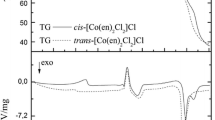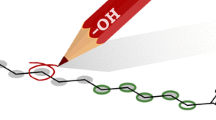Abstract
During aerobic incubation of trichloroethylene with rabbit liver microsomes and NADPH a difference absorption peak appears at 451–452 nm. Trichloroethylene does not form a ligand absorption spectrum with hepatic microsomes reduced by dithionite, or in anaerobic incubates in the presence of NADPH.
Addition of trichloroethylene epoxide (2,2,3-trichloro-oxirane) to reduced suspensions of rabbit liver microsomes produces high difference absorption at 452 nm, the optical K s being approximately 2 mM. Of all possible metabolites of trichloroethylene only trichloroethanol forms absorption in the vicinity of 480 nm, and the broad absorption band reveals relatively low absorption near 450 nm. Dichloroacetyl chloride is the main thermal rearrangement product of trichloroethylene epoxide, and also produces 452 nm absorption in reduced microsomes. However, the difference absorption is 5 times smaller than the absorption produced by the intermediate formed during incubation of trichloroethylene in metabolising liver microsomes.
These observations include strong evidence for epoxide formation during microsomal oxidation of trichloroethylene. 14C-labelled trichloroethylene binds irreversibly to hepatic macromolecules in vivo and in vitro. Possible rearrangement pathways of 2,2,3-trichloro-oxirane and reactive intermediates are presented.
Zusammenfassung
Während der aeroben Inkubation von Trichloräthylen mit Lebermikrosomen von Kaninchen und NADPH erscheint eine Differenz-Absorption mit dem Maximum bei 451–452 nm. Trichloräthylen bildet kein Liganden-Absorptionsspektrum mit Dithionit-reduzierten Lebermikrosomen oder bei anaerober Inkubation in Gegenwart von NADPH.
Die Zugabe von Trichloräthylen-Epoxid (2,2,3-Trichloroxiran) zu reduzierten Suspensionen von Lebermikrosomen von Kaninchen erzeugt eine hohe Differenzabsorption bei 452 nm; der optische K s liegt ungefähr bei 2 mM. Von allen möglichen Metaboliten des Trichloräthylens erzeugt nur Trichloräthanol eine Absorption im Bereich von 480 nm, und die breite Absorptionsbande zeigt vergleichsweise geringe Absorption in der Nähe von 450 nm. Dichloracetylchlorid ist das hauptsächliche thermische Umlagerungsprodukt von Trichloräthylen-Epoxid und erzeugt ebenfalls eine Absorption bei 452 nm in reduzierten Mikrosomen. Die Differenzabsorption ist allerdings fünfmal kleiner als die während der Inkubation von Trichloräthylen in stoffwechselnden Lebermikrosomen durch gebildete Zwischenprodukte erzeugte Absorption.
Die Befunde deuten stark auf die Bildung eines Epoxids bei der mikrosomalen Oxidation von Trichloräthylen hin. 14C-markiertes Trichloräthylen wird in vivo und in vitro irreversibel an Makromoleküle der Leber gebunden. Mögliche Umlagerungswege von 2,2,3-Trichloroxiran und reaktionsfähige Zwischenprodukte werden dargestellt.
Similar content being viewed by others
References
Baerge, R. D., Kimberg, D. V.: Centrilobular hepatic necrosis and acute renal failure in solvent sniffers. Ann. intern. Med. 74, 317–320 (1970)
Bauer, M., Rabens, S. F.: Cutaneous manifestation of trichloroethylene toxicity. Arch. Dermatol. 110, 886–890 (1974)
Bonse, G., Henschler, D.: Chemical reactivity, biotransformation, and toxicity of polychlorinated aliphatic compounds. CRC Crit. Rev. Toxicol. 4, 395–409 (1976)
Bonse, G., Urban, Th., Reichert, D., Henschler, D.: Chemical reactivity, metabolic oxirane formation and biological reactivity of chlorinated ethylenes in the isolated perfused rat liver preparation. Biochem. Pharmacol. 24, 1829–1834 (1975)
Byington, K. H., Leibman, K. C.: Metabolism of trichloroethylene in liver microsomes. II. Identification of the reaction product as chloral hydrate. Molec. Pharmacol. 1, 247–254 (1965)
Carlson, G. P.: Enhancement of the hepatotoxicity of trichloroethylene by inducers of drug metabolism. Res. Commun. Chem. Path. Pharmacol. 7, 637–640 (1974)
Cooper, J. R., Friedman, P. J.: The enzymatic oxidation of chloral hydrate to trichloroacetic acid. Biochem. Pharmacol. 1, 76–82 (1958)
Cox, P. J., King, L. J., Parke, D. V.: A comparison of the interactions of trichlorofluoromethane and carbon tetrachloride with hepatic cytochrome P-450. Biochem. J. 130, 87 p (1972)
Daniel, J. W.: The metabolism of 36Cl-labelled trichloroethylene and tetrachloroethylene in the rat. Biochem. Pharmacol. 12, 795–802 (1963)
Defalque, R. J.: Pharmacology and toxicology of trichloroethylene. Clin. Pharmacol. Ther. 2, 665–688 (1961)
Derkosch, J.: Personal communication (1974)
Derkosch, J., Ernstbrunner, E., Hoffmann, E. G., Österreicher, F., Ziegler, E.: Die Schwingungsspektren von Tetrachloräthylenoxid, cis- und trans-1,2-Dichloräthylenoxid. Mh. Chemie 98, 956–966 (1967)
DHEW: Memorandum, Dept. of Health, Education and Welfare, Washington, 20. 3. 1975; and Carcifnnogenesis bioassay of trichloroethylene, National Cancer Institute. Carcinogenesis technical report series No. 2, February 1976, DHEW publication No. (NIH) 76–802
Ertle, T., Henschler, D., Müller, G., Spassowski, M.: Metabolism of trichloroethylene in man. I. The significance of trichloroethanol in long-term exposure conditions. Arch. Toxicol. 29, 171–188 (1972)
Greim, H., Bonse, G., Radwan, Z., Reichert, D., Henschler, D.: Mutagenicity in vitro and potential carcinogenicity of chlorinated ethylenes as a function of metabolic oxirane formation. Biochem. Pharmacol. 24, 2013–2017 (1975)
Griesbaum, K., Kibar, R., Pfeffer, B.: Synthese und Stabilität von 2,3-Dichloroxiranen. Liebigs Ann. Chem. 1975, 214–224
Henschler, D. (Ed.): Trichloräthylen. In: Gesundheitsschädliche Arbeitsstoffe. Toxikologisch-arbeitsmedizinische Begründung von MAK-Werten. Weinheim: Verlag Chemie 1972
Jaeger, R. J., Conolly, R. B., Murphy, S. D.: Diurnal variation of hepatic glutathione concentration and its correlation with 1,1-dichloroethylene inhalation toxicity in rats. Res. Commun. Chem. Path. Pharmacol. 6, 465–471 (1973)
Joron, G. E., Cameron, D. G., Halpenny, G. W.: Massive necrosis of the liver due to trichloroethylene. Canad. med. Ass. J. 73, 890–891 (1955)
Kimmerle, G., Eben, A.: Metabolism, excretion and toxicology of trichloroethylene after inhalation. 1. Experimental exposure on rats. Arch. Toxicol. 30, 115–126 (1973a). 2. Experimental human exposure. Arch. Toxicol. 30, 127–138 (1973b)
Klaassen, C. D., Plaa, G. L.: Relative effects of various chlorinated hydrocarbons on liver and kidney function in mice. Toxicol. appl. Pharmacol. 9, 139–151 (1966)
Köbrich, G., Grosser, J., Werner, W.: Zur Umlagerung von Li-Alkoxiden aus Dichlormethyllithium und Carbonylverbindungen in α-Chloroxirane und α-Chloraldehyde. Chem. Ber. 106, 2610–2619 (1973)
Kylin, B., Reichard, Sümegi, I., Yllner, S.: Hepatotoxicity of inhaled trichloroethylene, tetrachloroethylene and Chloroform. Single exposure. Acta Pharmacol. Toxicol. 20, 16–26 (1963)
Kylin, B., Sümegi, I., Yllner, S.: Hepatotoxicity of inhaled trichloroethylene and tetrachloroethylene. Long term exposure. Acta Pharmacol. Toxicol. 22, 379–385 (1965)
Leibman, K. C.: Metabolism of trichloroethylene in liver microsomes. I. Characteristics of the reaction. Molec. Pharmacol. 1, 239–246 (1965)
Leibman, K. C., Ortiz, E.: Microsomal metabolism of chlorinated ethylenes. Sixth Int. Congr. Pharmacology, Helsinki 1975, Abstr. 608, p. 257
Lord, R. C., Nolin, B.: Vibrational spectra of ethylene oxide and ethylene oxide-d4. J. Chem. Phys. 24, 656–658 (1956)
Mansuy, D., Nastainczyk, W., Ullrich, V.: The mechanism of halothane binding to microsomal cytochrome P-450. Naunyn-Schmiedeberg's Arch. Pharmacol. 285, 315–324 (1974)
McBirney, R. S.: Trichloroethylene and dichloroethylene poisoning. Arch. industr. Hyg. 10, 130–133 (1954)
McDonald, R. N., Steppel, R. N.: Molecular rearrangement. VII. Neat, thermal rearrangement of optically active 2-chloronorbornene exo-oxide. J. Amer. chem. Soc. 91, 782–784 (1969)
McDonald, R. N., Steppel, R. N.: Molecular rearrangements. XI. The synthesis and neat, thermal rearrangement of (+)-(1R, 3R)-2-chloronorbornene exo-oxide. J. Amer. chem. Soc. 92, 5664–5670 (1970)
Müller, G., Spassovski, Henschler, D.: Trichloroethylene exposure and trichloroethylene metabolites in urine and blood. Arch. Toxicol. 29, 335–340 (1972)
Müller, G., Spassovski, Henschler, D.: Metabolism of trichloroethylene in man. II. Pharmacokinetics of metabolites. Arch. Toxicol. 32, 283–295 (1974)
Nagendrappa, G., Griesbaum, K.: Rearrangement of 2,3-dichloro-2-norbornene epoxide. Chem. Ind. (Lond.) 1973, 902–903
Österreicher, F.: Dissertation, Naturw. Fak., Wien 1967
Powell, J. F.: Trichloroethylene: absorption, elimination and metabolism. Brit. J. industr. Med. 2, 142–145 (1945)
Reiner, O.: Athanassopoulos, Hellmer, K. H., Murray, R. E., Uehleke, H.: Bildung von Chloroform aus Tetrachlorkohlenstoff in Lebermikrosomen, Lipidperoxidation und Zerstörung von Cytochrom P-450. Arch. Toxicol. 29, 219–233 (1972)
Reiner, O., Uehleke, H.: Bindung von Tetrachlorkohlenstoff an reduziertes mikrosomales Cytochrom P-450 und an Häm. Hoppe-Seylers Z. physiol. Chem. 352, 1048–1052 (1971)
Traylor, P. S., Nastainczyk, W., Ullrich, V.: Conversion of trichloroethylene to carbon monoxide by microsomal cytochrome P-450. Hoppe-Seylers Z. physiol. Chem. 357, 1060–1061 (1976)
Uehleke, H.: The model system of microsomal drug activation and covalent binding to endoplasmic proteins. In: Experimental model systems in toxicology and their significance in man. Proc. Europ. Soc. for the Study of Drug Toxicity, Zürich, 1973. Vol. XV, pp. 119–129. Amsterdam: Excerpta Medica Foundation 1973
Uehleke, H.: Binding of haloalkanes to liver microsomes. In: Active Intermediates: Formation, Toxicity and Inactivation (J. R. Gillette, D. Jollow, J. J. Kocsis, H. Remmer, F. Snyder, H. Vainio, A. Hänninen, eds.). New York: Plenum 1977
Uehleke, H., Hellmer, K. H., Tabarelli, S.: Binding of 14C-carbon tetrachloride to microsomal proteins in vitro and formation of CHCl3 by reduced microsomes. Xenobiotica 3, 1–11 (1973a)
Uehleke, H., Hellmer, K. H., Tabarelli-Poplawski, S.: Metabolic activation of halothane and its covalent binding to liver endoplasmic proteins in vitro. Arch. Pharmacol. 279, 39–52 (1973b)
Uehleke, H., Poplawski, S., Bonse, G., Henschler, D.: Spectral evidence for 2,2,3-trichloro-oxirane formation during microsomal trichloroethylene oxidation. Naunyn-Schmiedeberg's Arch. Pharmacol. 293 (Suppl.), R 64 (1976)
Uehleke, H., Schnitger, F., Hellmer, K. H.: Verhalten verschiedener mikrosomaler Fremdstoff-Oxidationen nach Inaktivierung von Cytochrom P-450 durch UV-Bestrahlung oder durch Desoxycholatbehandlung. Hoppe Seylers Z. physiol. Chem. 351, 1475–1484 (1970)
Uehleke, H., Werner, Th.: A comparative study on the irreversible binding of labelled halothane, trichlorofluoromethane, chloroform and carbon tetrachloride to hepatic protein and lipids in vitro and in vivo. Arch. Toxicol. 34, 289–308 (1975)
Smith, G. F.: Trichloroethylene: A review. Brit. J. industr. Med. 23, 249–262 (1966)
Williams, J. W.: The toxicity of trichloroethylene. J. occup. Med. 1, 549–554 (1959)
Author information
Authors and Affiliations
Rights and permissions
About this article
Cite this article
Uehleke, H., Tabarelli-Poplawski, S., Bonse, G. et al. Spectral evidence for 2,2,3-trichloro-oxirane formation during microsomal trichloroethylene oxidation. Arch Toxicol 37, 95–105 (1977). https://doi.org/10.1007/BF00293858
Received:
Issue Date:
DOI: https://doi.org/10.1007/BF00293858




